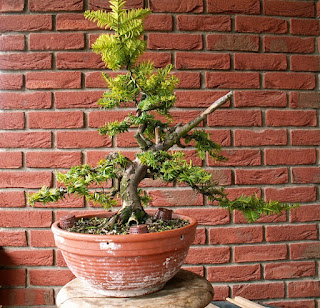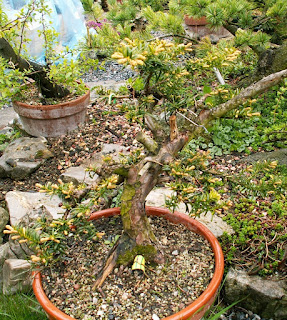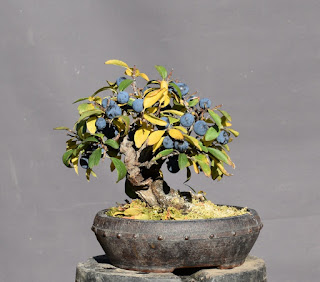My first yew
Forget about YAMADORI when it comes to yews.
There are not many yews in the wildness here in Czechia. And to protect the remaining ones they have the status of highly protected trees by law. So forget to collect it from the woodland. The only way is to collect from garden center/nursery or from your neighbor's garden once they are on a holiday...
My biggest yew is located in the front garden - I started to build a niwaki tree a few years ago and by now it starts to look presentable. The other two are in the mid-sized category with the target height around 50-70 cm. We will see.
The smaller one of this two has made a quite nice progress this year. So I thought it would be the right time to start some fine tuning to improve the overall appearance of the tree before the next season.
Spring 2017
Summer 2017
It is a shame that I do not recall what type of fertilizer I have used on this tree. From next to nothing it has moved to this:
The main target of my focus was the remains of the original trunk. Too straight. Too long. Grabbing much more attention than it deserves.
The plan:
1. change its direction
2. get some movement to it
3. reduce its length
DIRECTION
I have decided to make it QUICK but still reasonably nice.
Yes. My favourite Multiple C&C method (Cut and Close ). OK, clearly this one is NOT OK but the quality of the picture of the finished cut was too bad. There was another cut just at the entry point of the opening to make sure there is a better fit.
As I have planned some carving I have drilled a hole through both sections. Glued and doweled to make the joint firmer.
MOVEMENT
Now the main guest actor for this part was the Dremel and a few carving bits. Not too much at this stage just to get the idea of the final shape. So what next?
Well, I have decided to use a wet heat to make the wood more flexible. As far as I know this is a normal practice used by joiners. In the standard method a boiling steam is used. As this was a bit of a problem I have decided to check if a boiling water can help instead.
The jin has been wrapped in a piece of cloth. The rest of the tree has been protected by several layers of thin AL foil. I have also wrapped the cloth bandage by the AL foil to keep it as hot as possible, leaving only a small opening on the top. Boiling water has been poured on the jin. Hot water has been kept in a thermos flask.
In about 20 minutes I felt that the jin is giving less resistance to the pressure and I thought I can start the bending...
Eager to see the result? Great, but now it is a time for lunch.
There are not many yews in the wildness here in Czechia. And to protect the remaining ones they have the status of highly protected trees by law. So forget to collect it from the woodland. The only way is to collect from garden center/nursery or from your neighbor's garden once they are on a holiday...
My biggest yew is located in the front garden - I started to build a niwaki tree a few years ago and by now it starts to look presentable. The other two are in the mid-sized category with the target height around 50-70 cm. We will see.
The smaller one of this two has made a quite nice progress this year. So I thought it would be the right time to start some fine tuning to improve the overall appearance of the tree before the next season.
Spring 2017
It is a shame that I do not recall what type of fertilizer I have used on this tree. From next to nothing it has moved to this:
 |
| Possible front |
 |
| Back |
 |
| And the right side |
The plan:
1. change its direction
2. get some movement to it
3. reduce its length
DIRECTION
I have decided to make it QUICK but still reasonably nice.
MOVEMENT
Now the main guest actor for this part was the Dremel and a few carving bits. Not too much at this stage just to get the idea of the final shape. So what next?
Well, I have decided to use a wet heat to make the wood more flexible. As far as I know this is a normal practice used by joiners. In the standard method a boiling steam is used. As this was a bit of a problem I have decided to check if a boiling water can help instead.
The jin has been wrapped in a piece of cloth. The rest of the tree has been protected by several layers of thin AL foil. I have also wrapped the cloth bandage by the AL foil to keep it as hot as possible, leaving only a small opening on the top. Boiling water has been poured on the jin. Hot water has been kept in a thermos flask.
In about 20 minutes I felt that the jin is giving less resistance to the pressure and I thought I can start the bending...
Eager to see the result? Great, but now it is a time for lunch.










Comments
Post a Comment